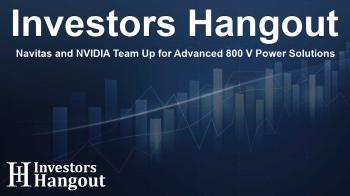Navitas and NVIDIA Team Up for Advanced 800 V Power Solutions

Navitas Partners with NVIDIA for Cutting-Edge Power Solutions
Navitas Semiconductor, recognized as a front-runner in power semiconductor technologies, has taken a monumental leap by teaming up with NVIDIA to innovate the next generation of 800 V high voltage direct current (HVDC) architecture. This partnership aims to meet the increasing power demands in data centers that support AI workloads, creating a robust foundation for scalable and efficient energy distribution.
Understanding the Need for 800 V HVDC Architecture
In today's fast-paced technological landscape, the rise of artificial intelligence has necessitated dramatic improvements in data center architecture. Conventional systems, which typically operate on 54 V power distribution, face limitations as demand for processing power surges. By shifting to an 800 V HVDC framework, NVIDIA aims to enhance efficiency, reliability, and reduce infrastructure complexity, paving the way for advanced AI computational capabilities.
The Current Landscape
Existing data centers are constrained by outdated systems that utilize bulky copper busbars to transmit low-voltage electricity. As power demands escalate beyond 200 kW, the inefficiencies inherent in these traditional architectures come to the forefront. One of the most pressing issues is the physical limitations of transferring power through copper, which becomes increasingly challenging with higher demand.
The Advantages of 800 V Systems
By adopting a direct 800 V HVDC architecture, power can be delivered with significantly lower current, which minimizes losses associated with resistance in copper wires. This design allows for a reduction in the thickness of copper needed, with estimates suggesting a decrease of up to 45%. Notably, switching to this architecture means less copper usage, which is especially critical for future-proofing technologies in the face of soaring energy needs.
Navitas' Role in Advancing Power Technology
Navitas is positioned as a leader in contributing cutting-edge solutions through GaNFast™ gallium nitride and GeneSiC™ silicon carbide technologies. These innovations are crucial for enabling efficient power delivery from the grid right to the GPUs used in NVIDIA’s systems, such as the Rubin Ultra.
Innovative GaN and SiC Technologies
GaNFast™ power ICs embody next-generation performance, integrating multiple critical features for reliability and efficiency. They showcase the latest advancements in semiconductor technology, including the integration of control, drive, and sensing capabilities, all of which serve to enhance performance and safety in intense operational environments.
GeneSiC's High-Performance Edge
Navitas’ GeneSiC technology complements GaNFast™ solutions by offering unmatched high-voltage performance across various applications. This combination ensures that systems can handle the high power requirements efficiently, supporting modern AI workloads while also reducing thermal footprint—a crucial element for any data center.
Strategic Benefits of Navitas and NVIDIA Collaboration
The collaboration between these two powerhouses is set to significantly elevate power efficiency in data centers. Predictions suggest that the new 800 V HVDC architecture could enhance end-to-end power efficiency by as much as 5%. Additionally, with fewer power supply failures, maintenance costs could plunge by up to 70%. This would not only streamline operations but also lead to lower cooling expenses due to enhanced thermal management.
Looking Ahead with AI Technology
The intersection of AI technology and advanced power solutions signals a pivotal moment for the industry. NVIDIA’s ambitious plans for their 800 V HVDC architecture reflect a comprehensive understanding of the future’s power needs, while also prioritizing sustainability and efficiency.
Navitas: A Vision for the Future
Gene Sheridan, CEO and co-founder of Navitas, expressed pride in the partnership, emphasizing the importance of technology that fosters more intricate AI systems. With a robust portfolio and deep commitment to innovation, Navitas is well positioned to support NVIDIA’s forward-thinking infrastructure initiatives.
Frequently Asked Questions
What is the purpose of the collaboration between Navitas and NVIDIA?
The collaboration focuses on developing a next-generation 800 V HVDC architecture to efficiently power AI workloads in data centers.
How does the 800 V HVDC architecture benefit data centers?
It reduces energy loss, minimizes the amount of copper required, enhances efficiency, and lowers operational costs associated with maintenance and cooling.
What are GaNFast and GeneSiC technologies?
GaNFast is a technology from Navitas utilizing gallium nitride for power semiconductors, while GeneSiC specializes in high-voltage silicon carbide devices, both enhancing power delivery systems.
What impact will this architecture have on AI computation?
The increased efficiency and power capacity will facilitate improved performance in AI computations, meeting the growing demands of modern technology.
How does this partnership support sustainable technology initiatives?
By reducing copper usage and enhancing energy efficiency, the collaboration aligns with sustainable practices in the semiconductor industry.
About The Author
Contact Kelly Martin privately here. Or send an email with ATTN: Kelly Martin as the subject to contact@investorshangout.com.
About Investors Hangout
Investors Hangout is a leading online stock forum for financial discussion and learning, offering a wide range of free tools and resources. It draws in traders of all levels, who exchange market knowledge, investigate trading tactics, and keep an eye on industry developments in real time. Featuring financial articles, stock message boards, quotes, charts, company profiles, and live news updates. Through cooperative learning and a wealth of informational resources, it helps users from novices creating their first portfolios to experts honing their techniques. Join Investors Hangout today: https://investorshangout.com/
The content of this article is based on factual, publicly available information and does not represent legal, financial, or investment advice. Investors Hangout does not offer financial advice, and the author is not a licensed financial advisor. Consult a qualified advisor before making any financial or investment decisions based on this article. This article should not be considered advice to purchase, sell, or hold any securities or other investments. If any of the material provided here is inaccurate, please contact us for corrections.

